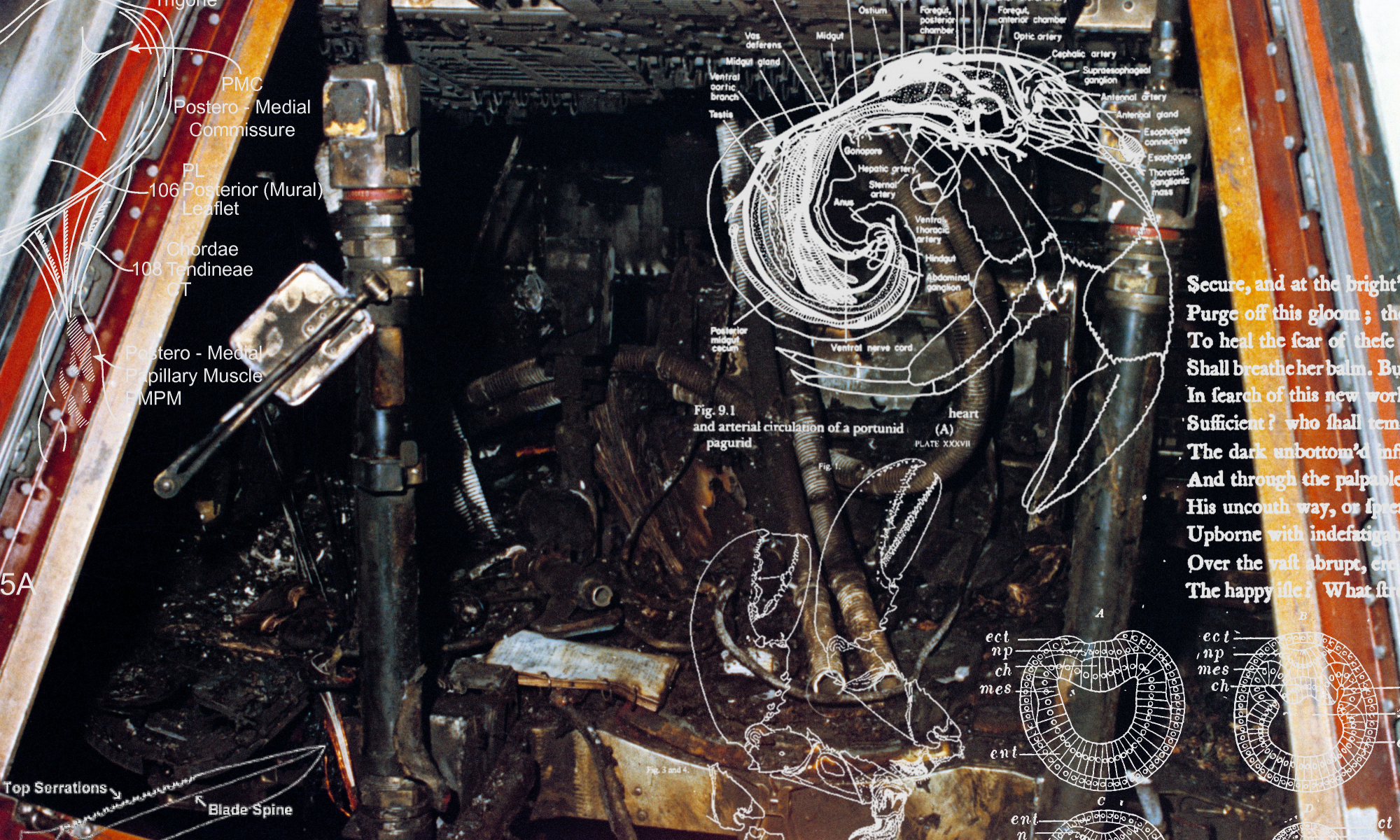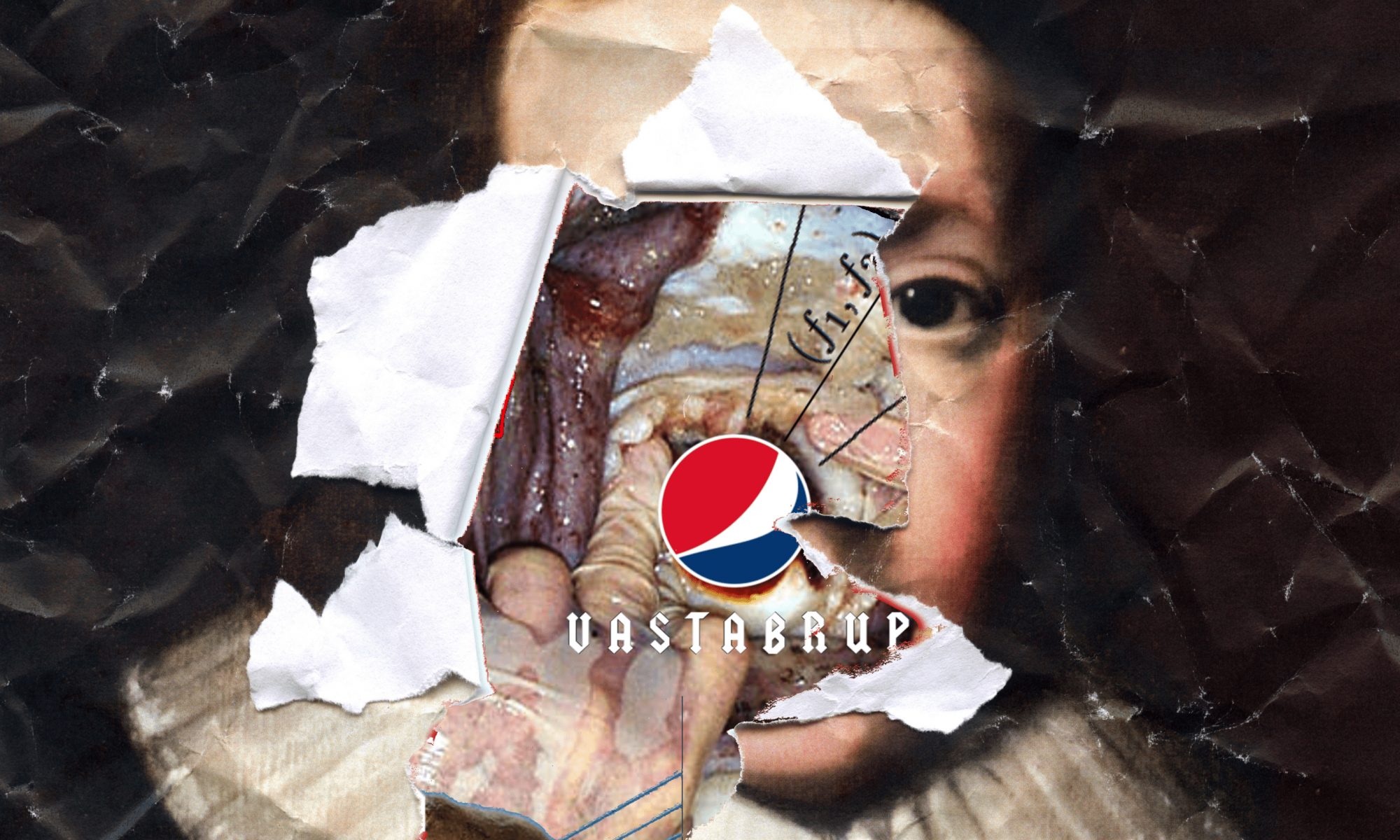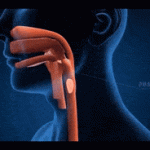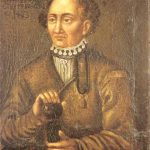Yesterday: ‘Crystal Pepsi / Crystal Hyaline: or, How to See with your Gut’
DAY 3. Peristaltic Metaphysics and the Invention of Pepsi
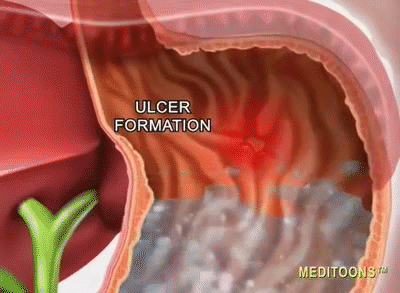
Milton connected his blindness to his gastric problems. He suffered from severe gout, and, moreover, was afflicted by stomach ulcers. His eventual death seems to have been caused — as recent biographers have argued, after consulting medical specialists — by a peptic ulcer (an ulcer of the gastrointestinal tract). It is feasible, his biographers write, that, besides gout, ‘Milton’s other chronic complaints […] included abdominal discomfort and bloating, consonant with [peptic ulcer]’.[note]G. Campbell, & T.N. Corns, John Milton: Life, Work and Thought (OUP, 2008), 211.[/note] (The flatulent poet lists “intestine stone and ulcer, colic pangs” on the menu of uniquely postlapsarian punishments for mankind [PL; xi.484.]
In 1893 — more than two centuries after Milton’s magnum opus — a North Carolina drugstore-owner by the name of Caleb Bradham (1867-1934), produced his own magnum opus. Of course, “magnum opus” originally refers to the alchemical-chyrsopoeian process of transmuting prima materia into the elixir of life; as his life’s achievement, Bradham’s product was indeed a veritable magnum opus, but rather than purifying matter into crystalline perspicuity, his elixir intensified the depuration and ontological liquefaction that had been set in motion with the Fall. In the terms of Chesterton’s adage, what Bradham had unleashed was inherently tied with this Fall, even in spite of its chronological distance. The twenty-six-year-old pharmacist had produced what he soon dubbed “Pepsi Cola”: a lapis philosophorum for the capitalized — that is, fallen — age.

Previously known simply as “Brad’s Drink”, Bradham — savvy businessman that he was — changed the name to Pepsi in order to advertise (camouflage) his beverage as a medicine. Hence, the name ‘Pepsi’, inspired by the Ancient Greek root πέπτω (‘peptō’, denoting digestion).[note]Dr. Pepper was possibly named with a similar proviso in mind. Everyone knows that Coca-Cola is so named because of its links to the then medicinal substance, cocaine.[/note] Thus Pepsi was first sold as a medicinal aid to eupepsia, exactly the issue that had so blackened Milton’s eyesight. However, carbonated water is now known to increase symptoms of an irritable bowel via the release of CO2 into the intestines.[note]This is likely why consumers subconsciously rejected the marketing collocation of Crystal Pepsi with hyaline perspicuity.[/note] This renders Bradham’s marketing highly ironic considering that Pepsi actually becomes a prime — at least, highly visible — lubricant for capital’s forces of terrestrial putrefaction and ontological liquidation, and, rather than any elixir of life, its surge across the globe represents thanatropic return to blackened prima materia.[note]CALEB BRADHAM = 178 = MELTDOWN = TIDAL WAVE[/note] Occult connections and synchronicities between Pepsi and Milton flow backwards into time from this point onwards. It was not only Pepsi, but carbonated drinks in general, that camouflaged their bootstrapped passage into the world via a tactical co-option of the ancient belief that fizzy drinks aid indigestion (and, in particular, peptic ulcers).[note]PEPTIC ULCER = 227 = TIME ANOMALY[/note] Milton — sufferer of severe dyspepsia and ulcer — will have been intimately aware of this tradition, and fittingly, Bradham capitalized on it by branding his new tarry drink with the tagline
Exhilarating, Invigorating, Aids Digestion.
Did Milton die — outmanoeuvred by his own internal peptic ‘satan’, an infernal and internal revolt — because he could not drink enough of Bradham’s Pepsi elixir? No. Quite the opposite: he was already drowning in templex cola. Imagine an autopsy report for the blind poet. His internal viscera coated in thick, black, sugary tartar. ‘How is this possible?’ you ask, reeling… ‘Pepsi invents itself from the future’ something whispers back. Suddenly, you understand the shape of terrestrial history.
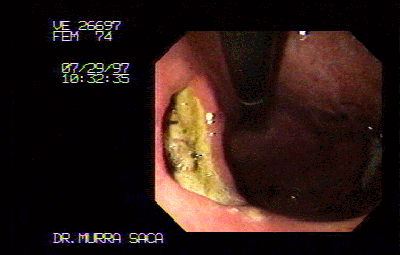
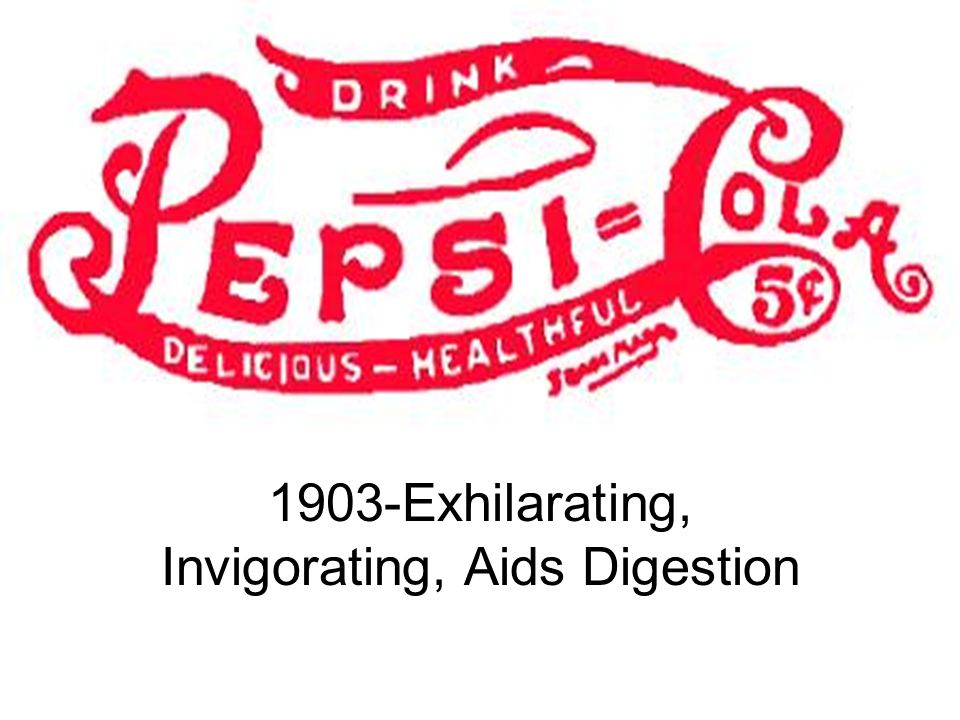
In his 1654 letter to François Thévenin — after delineating the medical connection between his dyspepsia and his blindness — Milton links himself to Phineus, the King of Thrace — brutally punished by the gods — a penalty that involved his eyesight being taken away. It simultaneously entailed him being eternally tortured by harpies who would constantly besmirch and befoul all of Phineus’s banquets and dinners. Excreting all over his food, the harpies ensured that the king would have to forever consume only indigestible putrescence. The reason why Phineus was prosecuted by the gods? Because, so the story goes, of his Promethean power of prophecy (the ability, that is, to see beyond empirical time and into the Outside that structures it). To punish his ability to see the future, the gods took away Phineus’s ability to see anything. Thus, here, Milton is subtly linking his own blindness and his own problems with food to a knack for prophecy. Like Phineus, Milton — for his prophetic part as templex harbinger of the unleashing of bootstrapping Chaos-Pepsi — also lost his sight. Insofar as Milton theorised upon the auto-productive tendencies of Chaos he was simultaneously prophesying upon the self-constructive tendency of the positive feedback loops constitutive of effervescing modernity. And prophecy, as they say, is indistinguishable from retrochronic information exchange. Bubbling Pepsi, via such retrojection, mobilises Chaos as a symbol and harbinger for itself.

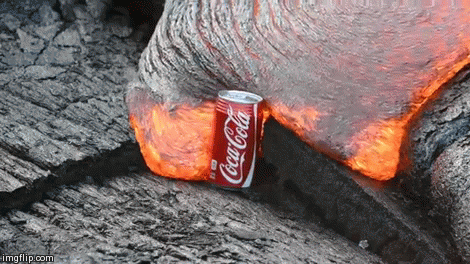

By weaving perception — and even reasoning — into a continuum with digestive process, Paradise Lost presents an uninterrupted metabolic continuity flowing from material to ideal. This is a founding ontological principle of Milton’s fictional world-model, his chronotope. The poet folds digestion inside-out: extending it extra-somatically, making it the cohesive — or binding — principle of his entire universe. Digestion becomes the heuristic under which Milton legitimates his well-known commitment to metaphysical monism. Thus: a nutritive monism. As he emphatically decrees, “whatever was created, needs / To be sustained and fed; of elements / The grosser feeds the purer” [PL; v.414-6]. On a number of occasions in Paradise Lost, Milton stresses that the universe is not constructed of divergent metaphysical orders, but is — rather — somewhat like a ‘holobiont’: an assemblage of varying ecological units that are nested within one alimentary unity. Indeed, even the “empyrean” is folded into continuity with this nourishing process. Lower feeds upon higher, interminably. Thus, the cosmos becomes cast as a universal process, weaving the higher and lower into a procedural nutritive unity. Indeed, in order to buttress his monistic commitments, this process of cosmic digestion lends itself to Milton as the perfect heuristic to illustrate a continuum between thinking and being, or even creator and creation, because digestion is the process whereby unorganised matter becomes organically structured into the make-up of life itself: it demonstrates, in deeply tangible terms, an actually existing continuum between ‘stuff’ and ‘spirit’, between ‘stoff’ und ‘geist’, that takes place constantly within all of our own bodies. (As another benefit, the universe’s metaphysical make-up therefore becomes intuitive through splanchnic interoception: therefore legitimating not intellectual intuition but metabolic intuition.) This is why, for example, Milton goes out of his way to stress that even angels require “food alike” to man, and feel “keen despatch / Of real hunger” [PL; v.407, 436]. Just as the lower is linked to the higher, because nutritive process is continuous with spiritual process, so too is the higher necessarily folded into the lower. In Book V, Adam offers sustenance to the visiting angel, Raphael. Adam — naïve and fresh-made — worries that his earthly nutriment may prove “unsavoury food perhaps / To spiritual natures” such as that of a seraphim. In response, Raphael eloquently — and politely — explains:
food alike those pure
Intelligential substances require
As doth your rational; and both contain
Within them every lower faculty
Of sense, whereby they hear, see, smell, touch, taste,
Tasting concoct, digest, assimilate,
And corporeal to incorporeal turn. [PL; v.407-13]
All beings exhibit anabolism, as “the creation groaneth and travileth” together for (digestive) salvation (Romans 8.22). All things “concoct, digest, assimilate”, thus “corporeal to incorporeal” tend. This intriguing schema, crucially, is a manoeuvre smuggled in from alchemical thinking.
The iatrochemists and chyrsopoeians had long been encouraged by biblical Genesis’s image of a universe created via a process of liquid separation, a hyaline distillation. It legitimated their idea that the universe was itself alchemical in fundamental nature. To put it differently, those who — with obsessive determination — laboured to imitate nature’s work (through the manufacture of artificial life in the pursuit of the alchemical homunculus) would obviously be allured by nature’s own imitation of their work. And what was nature’s imitation of alchemy? Digestion, of course. Biological metabolism can easily be cast as a mirroring — an ontological analogy — of the alchemist’s own, artificial procedures of distillation, purification, and subtilisation. Not only did alchemists consequently deploy this analogy to authenticate their own endeavour, they also used it as the foundation upon which to build a full-blown alchemical-digestive metaphysics. The renowned physician and iatrochemist Paracelsus (1493-1541) took this the furthest: resulting in his postulation that the entire universe is quite simply a stomach.[note]Instigator of modern chemistry, usurper of Galenic hegemony, and possible hermaphrodite, Philippus Aurelous Theophrastus Bombastus von Hohenheim — self-styled as Paracelsus — was a Swiss physician (born in a town called Egg) who, despite the amnesia of later ages, can be compared to a figure like Descartes in terms of the stature and extent of the influence he exerted.[/note]
Paracelsus was certain that everything was suffused within a liquid process of dialysis and filtration, the eternally continuing watery act of Genesis’s Creation. All things, he theorised, were ongoing, individualised versions of this original alchemical “firmament”: accordingly, Paracelsus located the “firmament” in man as his alimentary canal, and related it to the “firmament” in heaven (again, hyaloides to hyaline).[note]Paracelsus uses the idea of “limus terrae” as bridge between micro- and macrocosm. “Limus terrae” is the “primordial stuff of the earth” that God formed Adam out of, but it is also “an extract of the firmament, of the universe of stars, and at the same time of all the elements”. Star-stuff, indeed.[/note] To nomenclate his schema, Paracelsus invented his own idiosyncratic twist on the ancient anima mundi idea: the “archeus”, positioned as a cosmic digestive process, suffusing and conjoining all.[note]ARCHEUS = 138 = COSMOS[/note] The Great Chain of Being becomes a gastrointestinal tract, ontology a caecal labyrinth. For, as nature’s immanent alchemist, this archeus is the “physician of nature” and “the workman who gives origins by drawing and forging all”.[note]W. Pagel, Joan Baptista Van Helmont: Reformer of Science and Medicine (CUP, 2002), 99.[/note] All individual stomachs are objectivizations of this Absolute metabolism: conditioned individuations of an unconditional gut; an ur-gut which therefore becomes the very condition of possibility for all subsidiary digestions. Paracelsus’s influential Flemish disciple, Joan Baptiste van Helmont (1580-1644) accordingly spoke of this cosmological archeus as “comprehend[ing] and cherish[ing] within itself the Sun, and the herd of lesser stars, which diffuse[s] through all the limbes or parts of this great Animal, the World”.[note]W. Charleton, & J.B. van Helmont, A Ternary of Paradoxes: The Magnetick Cure of Wounds, Nativity of Tartar in Wine, Image of God in Man – Written Originally by Joh. Bapt. Van Helmont, and Translated, Illustrated, and Ampliated by Walter Charleton, Doctor in Physick, and Physician to the late King (London, 1650), 44.[/note] Microcosmically recapitulated in the individual, this becomes the “plastic spirit, [that] in the seed comprehends, contrives, and models the whole figure of Man […] limns out all the lineaments [of] the parts”.[note]Ibid., 58.[/note] Linking planetary distillation to gastric distillation, Helmont wrote that “in the bowels, the planetary Spirits doe most shine forth, even as also, in the whole influous Archeus, the courses and forces of the Firmament do appear”.[note]J.B. van Helmont, Oriatrike, or, Physick Refined: the common errors therein refuted, and the whole art reformed and rectified: being a new rise and progress of the phylosophy and medicine for the destruction of diseases and prolongation of life, trans. J. Chandler (London, 1662), 36.[/note] Man truly is the microcosm; but not through his head or through his heart; rather, he symbolises the cosmos through his gut. Our bowels are made of star-stuff, a black-eyed Carl Sagan would intone…
Such ideas soon made their way across the Channel to England, and thus to Milton. Thomas Tymme (?-1620), puritan clergyman and dabbler in alchemy, attempted to gloss the bible with his own vision of Paracelsian-digestive “Halchymie” (the prefix ‘Hal-‘ meaning ‘of the sea’, thus denoting the firmamental-gastric ocean that permeates through each individual).[note]Thomas Tymme, The Practise of Chymicall, and Hermeticall Physicke, for the preservation of health. Written in Latin by Iosephus Quersitanus, Doctor of Phisicke. And translated into English, by Thomas Timme, minister (London, 1605)[/note] Another major disseminator was Walter Charleton (1619-1707). He translated van Helmont’s De Magnetica Vulnerum (1621) and A Ternary of Paradoxes (1650). He would write, accordingly, of the “poverty of our Reason compared to the wealthy harvest of [van Helmont and Paracelsus]”.[note]W. Charleton & J.B. van Helmont, A Ternary of Paradoxes: The Magnetick Cure of Wounds, Nativity of Tartar in Wine, Image of God in Man – Written Originally by Joh. Bapt. Van Helmont, and Translated, Illustrated, and Ampliated by Walter Charleton, Doctor in Physick, and Physician to the late King (London, 1650), 96.[/note] Physician to Charles I and II, Charleton was personally known by many of Milton’s network of correspondents. Being a member of the Royal Society, Charleton knew Henry Oldenberg: a close friend of Milton’s. Furthermore, Oldenburg himself was acquantined with van Helmont’s own son: Francisus Mercurius van Helmont, publisher of his father’s works and his alchemical protégé. As early as 1658, Oldenburg had met the younger van Helmont (and described their “congress” together in a letter to Boyle).[note]Henry Oldenburg, The Correspondence of Henry Oldenburg, ed. A.R. Hall & M.B. Hall, xiii. (University of Winconsin Press, 1986), i.176-77.[/note] Between this time and 1671, Olenburg went from denigrating Franciscus to extolling the “distinguished van Helmont, who is very closely bound to me by friendship” (as Oldenberg boasted in letter to Leibniz).[note]Ibid., viii.182-3.[/note] Elsewhere, we see members of the so-called Hartlib circle (Hartlib also being a friend of Milton’s) involved with Helmontian dissemination (both Clerciuzio[note]A. Clericuzio, Elements, Principles and Corpuscles: A Study of Atomism and Chemistry in the Seventeenth Century (Springer, 2001), 90.[/note] and Hutton[note]S. Hutton, Anne Conway: A Woman Philosopher (Cambridge University Press, 2004), 143.[/note] have since noted the primacy of the Hartlib circle in promoting Helmontianism in England). Thus, we may safely guarantee Milton’s knowledge and awareness of this alchemical lineage: stretching from Paracelsus to the van Helmont family, through its English propagators, and finally to Milton himself.[note]Milton critics corroborate this hypothesis, noticing the presence of deeply Paracelsian ideas in Milton, and deeming these alchemists ‘chief sources’ for Milton’s philosophy. cf. Rogers, The Matter of Revolution: Science, Poetry, & Politics in the Age of Milton (Cornell University Press, 1996), 135.[/note] Concordantly, on just a cursory glance, we see that the metaphysical structure of Paradise Lost is suffused with archeus-type ideas, which help to prosecute Milton’s own version of a nutritive monism. As Raphael had said, everything — stretching from inorganic to spiritual — must “concot, digest, [and] assimilate”. He explicates further:
For know, whatever was created, needs
To be sustained and fed; of elements
The grosser feeds the purer, earth the sea,
Earth and the sea feed air, the air those fires
Ethereal, and as lowest first the moon;
Whence in her visage round those spots, unpurged
Vapours not yet into her substance turned.
Nor doth the moon no nourishment exhale
From her moist continent to higher orbs.
The sun that light imparts to all, receives
From all his alimental recompense
In humid exhalations, and at even
Sups with the ocean [PL; v.414-26]
Soaking in gastric imagery, we see here each rung of the Great Chain “feeding” the higher, providing “nourishment” that “exhale[s]” from “moist continent[s] to higher orbs”, which themselves “sup” upon “humid” and “alimental recompense” from below. Indeed, the Great Chain — as a conjunction of the Principle of Continuity and the Principle of Unilinear Progression — is easily retrofitted onto gastric sensibilities: Continuity implies that, because everything is infinitely divisible into itself, that nothing is inherently indigestible to Being; and, Unilinearity, implies a process of progressive peristalsis by which everything tends towards nourishment. Creation is a food-chain. In Charleton’s words, “every Creature doth […] possess a particular Firmament [i.e. digestive waters]; by the mediation of which, Superior bodies Symbolize, and hold a reciprocal correspondence with inferior, […] by the law of friendship”.[note]Charleton, Ternary of Paradoxes, 35.[/note] We see this “law of friendship” perfectly encapsulated here, as lower interminably nourishes higher. Returning to Paradise Lost, Raphael continues his exposition, describing how — “by gradual scale sublimed” — all of the “vital spirits aspire” up the scala naturae [PL; v.479]. Taken together in this cosmic peristalsis, all items exhibit the alchemical ideal of materials tending towards their purest state. And it is through his dance of digestive entelechy that we see the alembic universe tending toward perfect alchemic sublimation: towards purer, spiritual matter (spiritual anabolism, as “corporeal to incorporeal turn” [PL; v.413]). Indeed, it is implied that, through this great process, Adam and Eve could have eventually metabolised their somaform existences and fully sublimated themselves into angelic uncarnate forms. Angels are near to the top of the food-chain: accordingly, just as they enjoy more a more perspicuous intellectual essence, they all enjoy greater gastrointestinal apitutde and efficiency. As they are unrestricted by human finitude, they enjoy “intuitive” rather than “discursive” faculties of knowledge; and, correlatively, the angelic digestive tract is likewise noticeably more perfect. That is, angels hardly need to shit. Milton takes pains to point out that
what redounds, transpires
Through spirits with ease [PL; v.438-9]
Moreover, this angelic eupepsia is immediately described as being motored by a “concotive heat / To transubstantiate” foodstuff, just like the “empiric alchemist” who can turn “metals of drossiest ore to perfect gold” [PL; v.437-40]. And so, the universe is alchemical because the universe is digestive. This is the cosmic version of the alchemical magnum opus: the progression from nigredo, as base matter, upwards to spiritual purity.
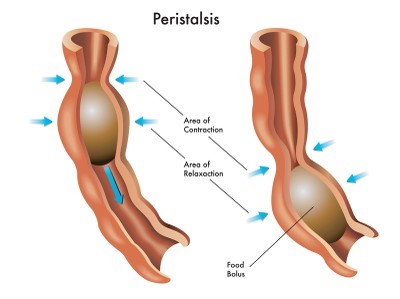
It is no wonder that Milton requisitioned the alchemical metaphysic, because it was so suited to his own commitments. For a start, because of his monistic predilections, Milton denied the ‘existence’ of ‘nothing’ with particular vehemence. He insists in his De Doctrina Christiana, following axioms from his Ars Logicae, that ‘nothing’ simply doesn’t have a place in the universe. (However, we shall soon see how his attempt actually galvanises void and substantivates zero.) He claims a thing cannot “be constructed out of nothing in the way it could from a number of components”.[note]De Doctrina Christiana in, Vol.VIII of The Complete Works of John Milton, ed. J.K. Hale & J.D. Cullington, (Oxford University Press, 2008- ), 289.[/note] (As such, it follows that “darkness was by no means nothing”: “[if] darkness is nothing, then God surely created nothing by creating darkness, that is, he did and did not create, which is a self-contradiction.)[note]Ibid.[/note] Consequently, denying a creatio ex nihilo and resisting any pre-existent matter outside of the Godhead, Milton comes to embrace creatio ex deo — a creation from out of God. Again, this is why the physiologically inflected archeus model lends itself so well to Miltonic cosmology. Creation is God’s digestive tract. In an internal process of subtilisation, God anabolises crude materials into structured creation. This, clearly, becomes a gastric twist on hylomorphism. God’s endogenous anabolic process lends forms to the base matter — the prima materia — of Creation. The Deity takes up matter and builds it up into increasingly subtile forms: just as our bodies subtilize nutrition into spirit. This transparently apes the Body-Politic: and, indeed, this hylomorphism is also precisely a form of governance. God, as the ‘head’, resides over the creative ‘belly’ by imparting his form and shape to the raw material of the archeus. On first glance, it at least seems that all of the subjects in this body-politic obey their sovereign. Describing the ‘gut flora’ of his cosmic holobiont, implying that the archeus descends to the most microscopic levels of matter, Milton writes that
Millions of spiritual creatures walk the earth
Unseen, both when we wake, and when we sleep:
All these with ceaseless praise his works behold
Both day and night: how often from the steep
Of echoing hill or thicket have we heard
Celestial voices to the midnight air,
Sole, or responsive each to other’s note
Singing their great Creator? [PL; iv.675-82]
All the taxonomies of Being sing the God that ingested, solidified and ‘stratified’ them into existence. Picking up the imagery of plenitude and casting it in strikingly similar language, Deleuze and Guattari write that
[e]very stratum is a judgement of God; not only do plants and animals, orchids and wasps, sing or express themselves, but so do rocks and rivers; every stratified thing on earth.[note]Deleuze and Guattari, A Thousand Plateaus (Continuum, 2004), 49.[/note]
However, as they go on to elaborate,
[t]he strata are judgements of God; stratification in general is the entire system of the judgement of God (but the earth, or the body without organs, constantly eludes that judgement, flees and becomes destratified, decoded, deterritorialised).[note]Ibid.[/note]
Where stratification is eupepsia, what are the chances — within Milton’s universe — of cosmic dyspeptic destratification? Just as angels still need to purge themselves, where is the nigredo, the tartareous excrement of the archeus? Will the earth itself fizz with effervescing, liquefying, sugary blackness, as the rebounding of the abyssal Deep from crystalline assimilation? Like a peptic ulcer unto the universe itself, all of that which exceeds assimilation — and thus refuses God’s stratifying forms — gains the troubling ability for auto-production. Matter-without-form, the rebellious excrement that exceeds divine digestion, is Chaos: which, surprisingly or unsurprisingly, since the Ancients, has also been referred to as “indigest”. (Ovid refers to Chaos as “rudis indigestaque moles”.) This was a collocation ripe for lock-in. Dryden wrote of the “[r]ude undigested Mass; / A lifeless Lump, unfashio’d and unfram’d, / Of jarring Seeds and justly Chaos nam’d”. Earlier, Shakespeare, in King John, had written of setting “form upon that indigest”. Being a substantive, or a nominalised adjective, Milton would certainly have appreciated Shakespeare’s language here: it is of a piece with “darkness visible”, “palpable obscure”, and — of course — “vast abrupt”.)[note]Cf. A recent article in MVU’s Plutonics journal on an intriguing orthographic anomaly found in new amanuensis manuscripts recovered from the Fitzbarrow estate. This orthographic puzzle appears as further proof of the templex cross currents streaming backwards between Pepsi and Miltonic verse.[/note]

Returning briefly to Deleuze and Guattari we note, in the section quoted above, the infamous announcement that “God is a Lobster”.[note]Deleuze and Guattari, A Thousand Plateaus (Continuum, 2004), 40.[/note] One wonders why it should be lobsters that bear the mark of infernal Pepsi on their doubly-articulating claws.[note]https://news.nationalgeographic.com/2017/11/lobster-claw-pepsi-soda-can-new-brunswick-spd/[/note] Why has Pepsi begun to invade even the abyssopelagic zones of the earth? And why has it chosen crustaceans as its avatar?

